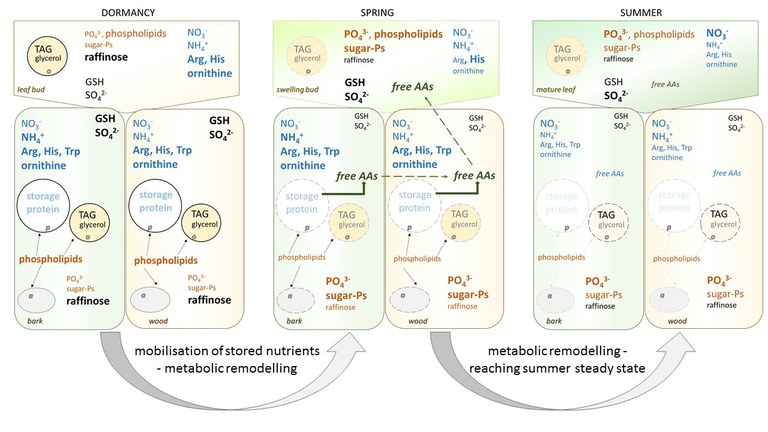research focus
The research focus of tree nutrition is best summarized by the changing profile of sulfur, nitrogen and phosphorus compounds during annual growth of Populus x canescens
The metabolite and lipid profile of poplar twig organs/tissues shows seasonal and tissue specific differences that can be linked to C (carbon), N (nitrogen) and S (sulphur) storage and mobilisation processes and exhibits the absence of any P (phosphorus) storage in poplar. Accumulation of phospholipids during dormancy in the stem bark and wood seems to be due to its need in membranes of amyloplasts, oleosomes and protein bodies, i.e. in subcellular compartments with high abundance during dormancy. Triacylglyceride (TAG) break down in all organs/tissues in spring indicates C mobilisation to support growth of the young, developing leaves. Furthermore, fatty acids from TAG degradation in poplar leaves may be used as carbon source for phospholipid and chlorophyll synthesis, but also for the formation of structural carbohydrates via gluconeogenesis. Protein accumulation as a N storage pool in the bark as well as in buds is complemented by the accumulation of the N rich amino acids Arg, Orn and His. In spring these amino acids support protein synthesis in leaf development; in case of their accumulation in bark parenchyma cells after its allocation to developing buds. Furthermore, sulphur is stored as sulphate and as GSH in the bark and wood. This brief summary demonstrates C, N and S storage and mobilization processes during annual growth of trees at the example of poplar. However, in case of poplar, storage and mobilization processes for phosphorus compounds was not evident. Nevertheless, remodelling of organic P compounds revealed their distinct need in specific processes depending on the season. This nutritional strategy for P differs from the climax tree species F. sylvatica and can be linked to the growth habitat of Populus x canescens in nutrient rich floodplains.

Figure: Seasonal differences in metabolite and lipid abundances of twig buds/leaves, bark and wood during the annual growth cycle are presented from winter dormancy via spring to summer. Bold and bigger letters demonstrate higher abundance of the compound in relation to other season(s). Vice versa smaller letter indicates lower amount of the respective compound in relation to other season(s). In dark orange written compounds relate to the P metabolism, in blue written compounds relate to the N metabolism whereas in black written metabolites refer to compounds of the carbon and sulphur metabolism. Light grey and light blue letters indicate the low abundance of TAG, glycerol and of protein at this time of the year. Black arrows show the places of phospholipids. Brocken lines of the protein body, the amyloplast and oleosome in spring indicate their degradation. For details see Watanabe et al., (2018). Abbreviations: a = amyloplast, o = oleosome, p = protein body, AAs proteinogenic amino acids. Adapted from Watanabe et al., 2018.

